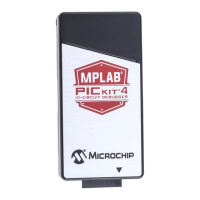2. About the Debugger
An overview of the MPLAB
®
PICkit
™
4 In-Circuit Debugger system is provided here.
2.1 MPLAB PICkit 4 In-Circuit Debugger Description
The MPLAB PICkit 4 In-Circuit Debugger (PG164140) allows fast and easy debugging and programming of Microchip
PIC
®
, dsPIC
®
, AVR, SAM and CEC (Arm
®
Cortex
®
-M7-based) microcontrollers using the powerful graphical user
interface of MPLAB X Integrated Development Environment (IDE).
The MPLAB PICkit 4 is connected to the design engineer's computer using a high-speed 2.0 USB interface and can
be connected to the target via a Microchip debug 8-pin Single In-Line (SIL) connector. The connector uses two device
I/O pins and the reset line to implement in-circuit debugging and In-Circuit Serial Programming
™
(ICSP
™
). An
additional microSDHC card slot and the ability to be self-powered from the target means you can take your code with
you and program on the go.
The MPLAB PICkit 4 programs faster than its predecessor (PICkit 3) and comes ready to support PIC, dsPIC, AVR,
SAM and CEC MCU devices. Along with a wider target voltage, the MPLAB PICkit 4 supports advanced interfaces
such as 4-wire JTAG, Serial Wire Debug (SWD), and streaming Data Gateway
1
, while being backward compatible for
demo boards, headers and target systems using 2-wire JTAG and ICSP. The MPLAB PICkit 4 also has a unique
Programmer-To-Go function with the addition of a microSDHC card slot to hold project code and the ability to be
powered by the target board.
The debugger system executes code like an actual device because it uses a device with built-in emulation circuitry,
instead of a special debugger chip. All available features of a given device are accessible interactively, and can be
set and modified by the MPLAB X IDE interface.
The MPLAB PICkit 4 In-Circuit Debugger is compatible with any of these platforms:
• Microsoft Windows
®
7 or later
• Linux
®
• macOS
™
The MPLAB PICkit 4 In-Circuit Debugger was developed for debugging embedded processors with rich debug
facilities which are different from conventional system processors in the following aspects:
• Processors run at maximum speeds.
• Capability to incorporate I/O port data input.
• Advanced host communication interfaces (Windows, macOS and Linux).
• Advanced communication mediums and protocols.
• Faster programming times.
In addition to debugger functions, the MPLAB PICkit 4 In-Circuit Debugger system also may be used as a device
production programmer.
Note:
1
The functionality will be available in a future firmware update of the product through MPLAB X IDE.
2.2 MPLAB PICkit 4 In-Circuit Debugger Advantages
The MPLAB PICkit 4 In-Circuit Debugger system provides the following advantages:
Features/Capabilities:
• Connects to computer via high-speed USB 2.0 (480 Mbits/s) cable.
• An 8-pin SIL programming connector and the option to use various interfaces.
• Programs devices using MPLAB X IDE or MPLAB IPE.
• Supports multiple hardware and software breakpoints, stopwatch, and source code file debugging.
• Debugs your application on your own hardware in real time.
• Sets breakpoints based on internal events.
About the Debugger
© 2020 Microchip Technology Inc.
User Guide
DS50002751D-page 7

